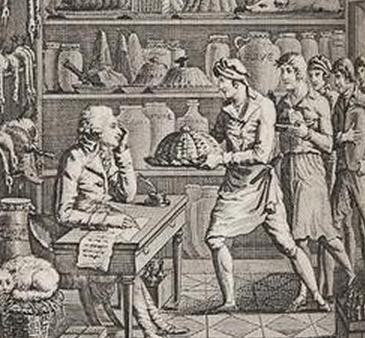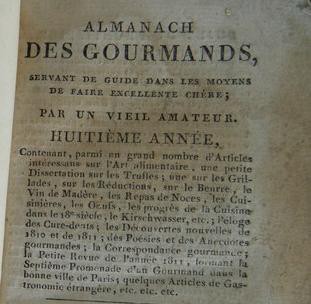The Perverse Secret Agenda of the Restaurant Critic
by Zach Maher

Last February, an iteration of the Olive Garden restaurant chain opened in Grand Forks, North Dakota. “The place is impressive,” Marilyn Hagerty wrote in her curiously favorable review for the Grand Forks Herald. “The chicken Alfredo ($10.95) was warm and comforting on a cold day. The portion was generous.” Hagerty’s review consisted almost entirely of declarative statements of fact about the restaurant’s décor, the size of its menu’s portions, and practical background info intended for prospective diners. Reactions to Hagerty’s subdued encomium ran the gamut of cosmopolitan condescension: from delight in her earnest sincerity to heartfelt pity.
Then in November, Pete Wells, restaurant critic for the New York Times, reviewed Guy’s American Kitchen & Bar, a 500-seat vasty hangar of a Times Square mess hall and the 11th restaurant opened by Food Network personality Guy Fieri. Guy’s American Kitchen & Bar was spun off from Fieri’s TV show “Diners, Drive-ins, and Dives.” The program features Fieri visiting unpretentious joints beloved by locals all over the nation and sampling the idiosyncratic fare in situ. The Food Network markets Guy’s televised road trip as a kind of roving celebration of vernacular American foodways. Wells’ review of the restaurant thusly inspired consisted of forty-six questions directed at Fieri: “Have you eaten at your new restaurant in Times Square?” Wells asked. “Did it live up to your expectations?” “When you cruise around the country for your show, rasping out slangy odes to the unfancy places where American like to get down and greasy, do you really mean it?”
Two days after Wells’ review appeared in the Times, Guy Fieri flew red-eye from his home in Northern California to defend his restaurant on NBC’s Today Show in New York City. “I have a problem with the tone, the sarcasm, and the question style,” the restaurateur complained to Savannah Guthrie. But the tone of Wells’ review, apart from a couple flights of ironic hyperbole, could hardly be called sarcastic. Mostly, Wells interrogated Fieri about the divergence between what’s on his menu (“Guy’s Famous Big Bite Ceasar”) and what’s on his plates (“a small salad with four or five miniature croutons.”). The review wasn’t a drubbing so much as it was an exercise in meticulous accountantship. That acid taste rising in your throat isn’t a bilious impulse, Wells assured us, the food actually tastes that way. But Guy Fieri was suspicious of ulterior motives on Wells’ part. “I think we all know what’s going on here,” Guy told Savannah on the Today Show, sitting before a plate of the questionable cuisine: “He came in with another agenda.”
Over the course of a two-minute chat with Savannah, Guy accused Wells of having an agenda, or ‘another’ agenda, three times.
Fieri seemed to suspect that Pete Wells came to Guy’s American Kitchen & Bar in bad faith, just itching to really pan the place, and this hypothesis seems improbable. A month after Wells’ review ran, the Times’ website hosted a Q&A; for the reviewer and the online forum was overrun with Fieri-related queries. To those questioners accusing him of elitist pot-shotting, Wells responded: “I respect what Mr. Fieri does in his show ‘Diners, Drive-Ins and Dives.’”
800 Olive Gardens have opened globally in twenty years. Surely everyone in America is past the introductory stage. And Guy Fieri’s target demo isn’t exactly coextensive with the readership of the Times’ ‘Dining’ section; a high-minded consideration might be misdirected. But both Hagerty and Wells reviewed a restaurant, new in town, for a local paper and in both instances, the subject was a surprising choice. The two restaurants are so obvious or otherwise unassuming as to be apparently beneath scrutiny. But if his agenda wasn’t to pick a fight or spit class bile, then what was Pete Wells doing at Guy’s American Kitchen & Bar?
The first restaurant reviewer was Alexandre Balthazar Laurent Grimod de la Reynière, (1758–1837), a Frenchman, disbarred attorney and lapsed theatre critic. He outlined his own agenda in the preface to the first volume of the Almanach des Gourmands. “The reversal of fortunes occasioned by the Revolution having placed wealth in new hands,” wrote Grimod de la Reynière (referring to the French one, of 1789), “and the newly rich desiring, above all, to employ their gains in sensual satisfactions, it was thought that a service might be rendered to the lately fortunate in the form of this guide, honest and true in its direction of their dearest affections.”

Grimod de la Reynière was uniquely qualified to serve as cicerone to the nouveaux riches milling about First-Empire Paris with full pockets, empty stomachs and uncivilized ideas about how the twain might meet. Before the Revolution, Grimod de la Reynière pere held the hereditary office of fermier général, collecting tax revenues per a contract with the king; such a windfall made the family one of the wealthiest in Ancien Regime France. Grimod learned how to use a fork, sort of, at his dad’s table, renowned for its bounty. Grimod’s congenitally malformed hands were cause for chagrin in the family: “one ended in a sort of talon,” a biographer notes. The right one was webbed, like a duck’s foot. His parents blamed a careless servant and a hungry pig. Commentators have quibbled about how he manipulated utensils. Nonetheless, the kid was excluded on the grandest occasions and whenever company was over to eat, an injustice that denied him his right and illustrious — an 18th-century diarist had dubbed Grimod pépé the foremost gourmand of that century — inheritance.
So it wasn’t until a period of peripatetic trial, imposed when an elaborate prank involving a funereal banquet and a pig dressed in the likeness of his father prompted disbarment and parental ejection from Paris, that Grimod truly learned how to feed. Banished, he was chased by the wolf into a monastery with ample provender. The welcoming party was an abbot near Nancy with a discerning palate and a hospitable inclination. The regional cuisine is heavy on cream and potato; Grimod was sufficiently inspired to briefly operate a gourmet delicatessen in Lyon. Few ecclesiastical indulgences have had happier consequences.

Bouleversement came in the form of the Revolution while Grimod fils was abroad cutting his teeth. The family was among those suddenly bereft of a livelihood. Tax collection was nationalized and Grimod’s father died of heartbreak. Grimod returned to Paris and tried his hand at theatrical reviews to support his mother; these were hungry times. Grimod was forced to let out the Hôtel Grimod de La Reynière, the grand family demesne just off Concorde, but stayed on in perpetuity as a rent-controlled tenant. Much later, the distressed property was eventually snapped up by the American embassy in Paris (who promptly outgrew the compound, razed it, and, with $10 million from Congress — $152 million, adjusted for inflation — threw up ‘un pastiche de style néo-classique’ on the valuable real estate).
The theatrical review that was Grimod’s outlet and only livelihood soon folded after his return to Paris, and the times went from hungry to starving. A gourmand thick or thin, Grimod wandered Les Halles for hours, calculating the tastiest expenditure of his last ecus. The butchers and greengrocers of the market, who once profited from the largesse of the father’s table, pitied the son’s humbled lot and supplied Grimod with delicacies at a cut rate. Thus it was probably here, at the massive central market where all of Paris bought its fruits, fish, meats and vegetables, that Grimod became intimately acquainted with cuisine’s new aristocracy: the restaurateurs.
“The revolution,” Grimod wrote in the Almanach, explaining the origin of the restaurant, “by forcing all those rentiers to go on a diet, forced the cooks out onto the street.” The political sympathies of chefs — formerly employed as servants of aristocratic appetite, after all — were suspect after regime change. (A self-identified ‘scullery boy’ and veteran of the kitchens of Marie Antoinette was convicted of “longing for the Old Regime” and given the patriotic haircut.) Many made the one career change totally beyond reproach: they became venture capitalists.
The restaurant was only a recent development. Rebecca Spang, in her indispensable The Invention of the Restaurant, describes the particular concatenation of effects that, in the decades before the Revolution, resulted in the novel institution: a fashion for healthful consumption among the smart Paris set; the Rousseauian assertion of individual liberty (to choose from a menu) and correspondent responsibility (to pay the bill); and, with clueless out-of-towners arriving in droves to roil the capital in the heady days before the Bastille, the commercialization of fraternal feeling into the hospitality industry. Neither private nor public, not old but not exactly new, the restaurant occasioned a pleasant bewilderment among Parisians in the twenty or so years around the Revolution, a frisson of confusion appropriate to the epoch. It was in this bittersweet spot that chefs hung a shingle and opened shop.
As Grimod must have realized while he drifted among the market stands at Les Halles, his stomach in a dull ache, and watched the marchands sell their tastiest cuts to upstart cooks, concessions would have to be made to the new and more liberal climate. In 1802, Grimod used the distinction of his good name to secure lines of credit and began entertaining lavishly. Distinguished gullets and friends who knew their way around a dinde aux truffes were invited to dine at the leveraged family manse. The restaurateurs, eager to advertise their creations to such a desirable demographic, were more than happy to serve their best. And a year later, the first volume of the Almanach des Gourmands appeared on the bookstalls. It promptly sold out of four editions.
Food writing was nothing new. Cookery guides and household vade mecums had been instructing eaters for centuries, usually with a salutary bent. Through the Middle Ages, ecclesiastical scholastics (particularly French clergy, for some reason) took pains to record what they ate and drank and how it was prepared (Belgian trappists still brew the best beer in the world with centuries-old recipes). And in contemporary Paris, Jean Anthelme Brillat-Savarin, another barrister, was excusing himself from esteemed tables and scribbling notes that would eventually become The Physiology of Taste, that efflorescence of gastronomic thought (“Compared to him, I’m but a kitchen slave,” Grimod said of his cross-town rival).

But the collations that Grimod la Reynière published annually in omnibus format for eight years didn’t have literary pretensions, like the work of Brillat-Savarin. And while Grimod’s work had practical value, it aspired to a particular kind of permanence in post-Revolutionary France that no cookbook attempted.
Grimod began his Almanach with a Calendrier nutritif, a schematization of the months of the year according to those foodstuffs most appropriate for consumption. “…January brings a cloud of fowl, each more delicate than the last; and to begin with the fattest of all, the wild duck, whose arrival acts as a delicate thermometer, by which we might read the temperature of the winter to come….” A recipe for Canards sauvage, entrusted to Grimod by a monk whose esteemed kitchen was a casualty of the Revolution, is shared with the reader. The passage of a year discloses an unprecedented bounty, drawn from every corner of the Republic to be enjoyed in the capital at just the right time.
Once a new gastronomic calendar was established, Grimod moved to redesign all of France according to his tastes. “Paris, where the high life is most exquisitely pursued,” forms the axis of the gastronomic world. “Every avenue into the city is choked with wagons carrying every variety of foodstuff, innumerable herds of every specie, all of it destined for ingestion by the bottomless Parisian consumer.” For the benefit of this gargantuan neophyte, seated at the Parisian dinner table and hungry for wisdom, Grimod unfolds his extensive Itinéraire nutritif, ou promenade d’un gourmand dans divers quartiers de Paris. Decades before Baudelaire’s legendary flânerie (what Balzac, with a characteristic perspicacity, recognized as merely a ‘gastronomy of the eye’), Grimod takes his appetite for a walk through Paris, past the most delicious pâtisserie, the most reliable grocers, the wisest butchers and the choicest restaurants. “Entering the Tuileries and walking along the terrace of Feuillans, we admire the restaurant of M. Véry, where the mahogany, the mirrors, the marble and the bronzes hint to the uninitiated at what awaits him, and secure the restaurant’s reputation as the most luxurious of its type in Paris.” Hints and rumours, gleaming wood and glinting mirrors: this seems like insubstantial stuff to offer hungry parvenus. But while the guide might point out the sights and explain their provenance, he lets his charges find their own way to the table.
“Indeed,” writes Spang in The Invention of the Restaurant, “Grimod seemingly mapped a whole new world: a region with its own saints, calendar and geography.”
Us, the clientele, we’re always tourists in this new world. Not only are restaurants constantly opening, renovating, going bust or moving uptown, but we are inclined to graze and constantly change pastures. A table can only be rented after all, and just for a few hours (next time you’re dining somewhere classy, try to find a conspicuous timepiece in the salle à manger; you won’t). Like most tourists, we don’t speak the language; at least not fluently. Whether it’s written in gastronomical French or Guy Fieri’s homey babble, the menu we’ve been handed is nonsensical. The names of the dishes are mere words unattached to any experience we’ve had, a list of places that we’ve never been to. And that’s how we like it: novel, uncharted. The confusion is why we’re here and not somewhere familiar; why we didn’t just prepare dinner for ourselves at home.
If the menu isn’t a cipher and the setting doesn’t induce a delightful vertigo, then you’ve become a regular. Marilyn Hagerty didn’t so much review the Olive Garden as confirm to eager (“…the lines were long in February…”) Grand Forxites that an exact copy of the eatery they all knew and loved had finally arrived. After all, the Olive Garden’s is one of the first chicken Alfredo recipes that result from a Google search. You can make it at home and it tastes just like you get at the restaurant, honest.
But for those of us who stray, we don’t want to get lost. We don’t want to waste time or cash. We’ve profited from some recent change of fortunes, our billfold is full and we’ve worked up an appetite. The idea is, another revolution will be effected: we’ll leave satisfied, our wallet that much lighter.
Since Grimod de la Reynière, restaurant critics have mapped uncharted territories for the benefit of the hungry. (Carte, in French, might mean a bill of fare or a navigational instrument). Sometimes the reviewer simply takes us by the claw and conducts us to the threshold, invites us to feast our eyes and gently insists that yes, this place is every bit as real as it seems. But not all restaurateurs are so ingenuous as Grimod’s pals the Messrs. Véry. Quality is rarely self-evident. Charlatanism is notoriously sanguine about its endeavours, tending to a bluntness that could easily be mistaken for honesty. And when we seem to have been led astray, that’s when a map helps to explain the difference between what we’re told and what we taste.
“I’m doing the type of food America loves and I’m doing it the right way,” Guy Fieri insisted on the Today Show. Are you? asked Pete Wells. Wells’ questions demonstrated that Guy Fieri doesn’t mean what he says, and that a Broadway’s breadth separates the cuisine Fieri fronts on TV from what might be ordered at Guy’s American Kitchen & Bar. “Why,” Wells, almost heartbroken, asked, “is the cooking you celebrate on television treated with so little respect at your restaurant?” His somewhat jowly portrait, familiar to every mâitre d’ in the city, attests to Wells’ sincerity and the extent of his expertise. And in other reviews, maps that Wells has drawn of foreign places all across New York, he simply explains that there are other, better spots to put our mouths and our money.
If you’d like to sublet your apartment, rent a villa in the Midi, or find love, Zach Maher sells classified ads at the New York Review of Books
. Otherwise, he can be tweeted at.
